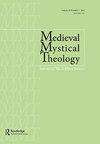Marrying Jesus in Medieval and Early Modern Northern Europe: Popular Culture and Religious Reform
IF 0.3
0 RELIGION
引用次数: 0
Abstract
and has come through a scepticism towards ‘grand narratives’, but nevertheless engages traditions rooted in other places and in other times, taking seriously their claims on human reality. Clooney’s book makes a case for a strong, committed theology within a pluralist world. There can, I think, be no resolution to the problem of universal theological claims in the contemporary, pluralist context, but Clooney offers a constructive way forward in his religious reading across traditions. This is, I suppose, an indirect philosophy of religions but it seems to me that the kind of truth the book is about (and the texts it is dealing with) can only be approached elliptically. Clooney lets the poetry speak for itself in a process of crossreading and close reading, in which the truth of the traditions speaks to those who can hear. In a parallel move Flood avoids religious truth by generating ‘secular’ theory about the shared nature of human subjectivity that in the end is neither Christian, nor Hindu, nor Buddhist. There is an issue regarding religious truth that neither Clooney nor Flood directly addresses; indeed there is a sense in which questions of truth actually serve to obscure religious meaning and the meaning of texts for contemporary readers that both authors seek to avoid. The meanings of Clooney’s texts speak to human inwardness, to the reality of longing for an absent lover who lies hidden in the heart, and to the finitude of human life. This assumes a certain degree of sensitivity not only to poetry but to a mystical sentiment that allows the reader to let the readings so carefully presented speak to her; somebody who is not interested, for whom the one who hides in darkness does not speak, will simply not read the book. But there is great optimism that reading can change us, can improve us, and can point to a fullness of meaning to enrich our lives. It is here that there is a possible overlap with a hidden telos in The Truth Within, that displaying inwardness as it has occurred in history is to reveal something important about contemporary life and human subjectivity even under the conditions of late modernity. As Clooney’s book shows, to agree upon a shared subjectivity does not dissolve human problems but rather emphasizes the incompletion of both the stories told and the lives lived. Yet this is a place of hope, especially important in a world of polarization and fundamentalisms, in not deciding things too quickly, as Clooney eloquently puts it, ‘as if faith needs an end to questing because it cannot suffer poetry and the drama of uncertain love’ (141).中世纪和近代早期北欧与耶稣结婚:大众文化与宗教改革
他对“宏大叙事”持怀疑态度,但仍然采用植根于其他地方和其他时代的传统,认真对待它们对人类现实的主张。克鲁尼的书在一个多元化的世界里提出了一个强有力的、坚定的神学。我认为,在当代多元主义的背景下,普遍神学主张的问题是没有解决办法的,但克鲁尼在他的跨传统宗教阅读中提供了一种建设性的前进方式。我想,这是一种间接的宗教哲学,但在我看来,这本书所涉及的真理(以及它所涉及的文本)只能以椭圆形的方式接近。克鲁尼让诗歌在交叉阅读和细读的过程中为自己说话,在这种过程中,传统的真相向那些能听到的人说话。在一个平行的运动中,弗拉德通过产生关于人类主体性的共同本质的“世俗”理论来回避宗教真理,这种理论最终既不是基督教,也不是印度教,也不是佛教。有一个关于宗教真理的问题,克鲁尼和弗拉德都没有直接提到;事实上,在某种意义上,真理的问题实际上是为了模糊宗教意义和文本对当代读者的意义,这是两位作者都试图避免的。克鲁尼文本的意义是对人的内在,对隐藏在心中的一个缺席的爱人的渴望的现实,以及人类生命的有限性。这就要求读者不仅对诗歌有一定程度的敏感性,而且对一种神秘的情感也有一定程度的敏感性,这种情感使读者能够让如此精心呈现的阅读对她说话;那些不感兴趣的人,那些躲在黑暗里不说话的人,根本不会读这本书。但也有很大的乐观,阅读可以改变我们,可以提高我们,可以指向一个充实的意义,丰富我们的生活。这可能与《内在的真相》中隐藏的目的重叠,即在历史上展示内在性是为了揭示一些关于当代生活和人类主体性的重要东西,即使是在现代性晚期的条件下。正如克鲁尼在书中所表明的那样,就共同的主观性达成一致并不能解决人类的问题,而是强调了所讲述的故事和所经历的生活的不完整。然而,这是一个充满希望的地方,在一个两极分化和原教旨主义的世界里尤其重要,因为不要太快地决定事情,正如克鲁尼雄辩地说的那样,“好像信仰需要一个结束,因为它不能忍受诗歌和不确定的爱情的戏剧”(141)。
本文章由计算机程序翻译,如有差异,请以英文原文为准。
求助全文
约1分钟内获得全文
求助全文

 求助内容:
求助内容: 应助结果提醒方式:
应助结果提醒方式:


